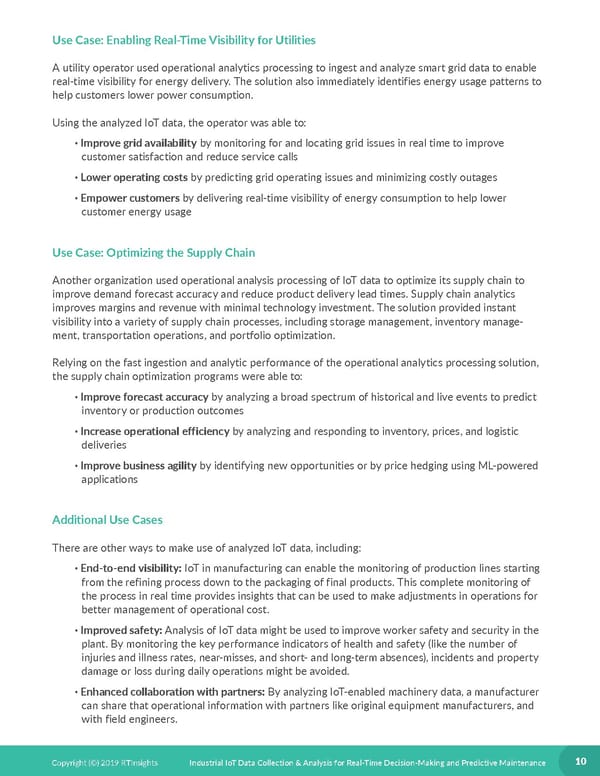Use Case: Enabling Real-Time Visibility for Utilities A utility operator used operational analytics processing to ingest and analyze smart grid data to enable real-time visibility for energy delivery. The solution also immediately identifies energy usage patterns to help customers lower power consumption. Using the analyzed IoT data, the operator was able to: · Improve grid availability by monitoring for and locating grid issues in real time to improve customer satisfaction and reduce service calls · Lower operating costs by predicting grid operating issues and minimizing costly outages · Empower customers by delivering real-time visibility of energy consumption to help lower customer energy usage Use Case: Optimizing the Supply Chain Another organization used operational analysis processing of IoT data to optimize its supply chain to improve demand forecast accuracy and reduce product delivery lead times. Supply chain analytics improves margins and revenue with minimal technology investment. The solution provided instant visibility into a variety of supply chain processes, including storage management, inventory manage- ment, transportation operations, and portfolio optimization. Relying on the fast ingestion and analytic performance of the operational analytics processing solution, the supply chain optimization programs were able to: · Improve forecast accuracy by analyzing a broad spectrum of historical and live events to predict inventory or production outcomes · Increase operational efficiency by analyzing and responding to inventory, prices, and logistic deliveries · Improve business agility by identifying new opportunities or by price hedging using ML-powered applications Additional Use Cases There are other ways to make use of analyzed IoT data, including: · End-to-end visibility: IoT in manufacturing can enable the monitoring of production lines starting from the refining process down to the packaging of final products. This complete monitoring of the process in real time provides insights that can be used to make adjustments in operations for better management of operational cost. · Improved safety: Analysis of IoT data might be used to improve worker safety and security in the plant. By monitoring the key performance indicators of health and safety (like the number of injuries and illness rates, near-misses, and short- and long-term absences), incidents and property damage or loss during daily operations might be avoided. · Enhanced collaboration with partners: By analyzing IoT-enabled machinery data, a manufacturer can share that operational information with partners like original equipment manufacturers, and with field engineers. Copyright (©) 2019 RTInsights Industrial IoT Data Collection & Analysis for Real-Time Decision-Making and Predictive Maintenance 10 Copyright (©) 2019 RTInsights Industrial IoT Data Collection & Analysis for Real-Time Decision-Making and Predictive Maintenance
 Industrial IoT eBook Page 9 Page 11
Industrial IoT eBook Page 9 Page 11